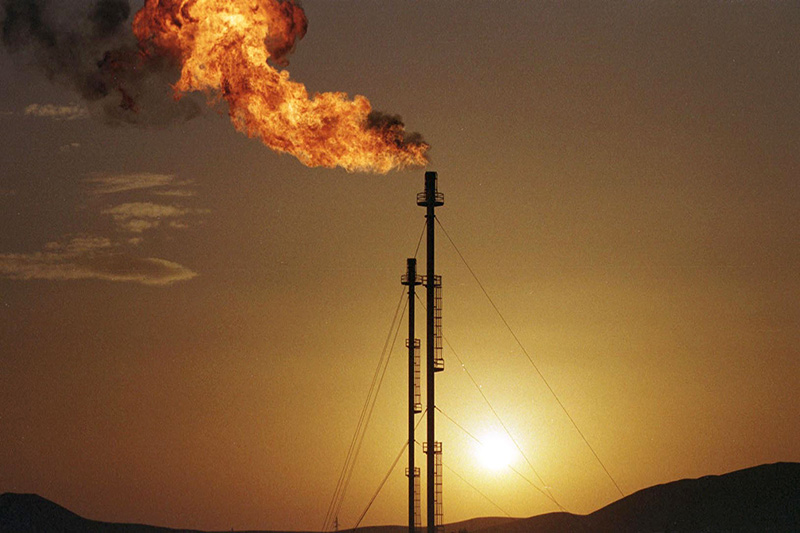Investing.com - Natural gas futures were higher during U.S. morning trade on Thursday, holding on to gains after a report from the U.S. Energy Information Administration showed U.S. gas supplies rose broadly in line with market expectations last week.
On the New York Mercantile Exchange, natural gas futures for delivery in October traded at USD2.792 per million British thermal units during U.S. morning trade, jumping 1.1%.
It earlier rose by as much as 2.1% to trade at a session high of USD2.821 per million British thermal units.
The October contract traded at USD2.794 prior to the release of the U.S. Energy Information Administration report.
The U.S. Energy Information Administration said in its weekly report that natural gas storage in the U.S. in the week ended September 14 rose by 67 billion cubic feet, just above market expectations for an increase of 64 billion cubic feet.
Inventories rose by 89 billion cubic feet in the same week a year earlier, while the five-year average change for the week is an increase of 73 billion cubic feet, according to U.S. Energy Department data.
Total U.S. natural gas storage stood at 3.469 trillion cubic feet as of last week. Stocks were 320 billion cubic feet higher than last year at this time and 278 billion cubic feet above the five-year average of 3.218 trillion cubic feet for this time of year.
Inventory did not top the 3.4-trillion cubic feet level in 2011 until October 5, with stocks peaking at a record 3.852 trillion cubic feet in November of last year.
The report showed that in the East Region, stocks were 76 billion cubic feet above the five-year average, following a net injection of 44 billion cubic feet.
Stocks in the Producing Region were 150 billion cubic feet above the five-year average of 974 billion cubic feet, after a net injection of 20 billion cubic feet.
Market analysts have warned that without strong demand through the rest of the summer cooling season, gas inventories will reach the limits of available capacity later this year.
A bout of extreme heat across much of the U.S. earlier in the summer helped boost natural gas prices above the key USD3.00-level in late-July. Prices rallied to a 2012 high of USD3.275 per million British thermal units on July 31.
But futures have come under heavy selling pressure since the start of August, losing almost 12% after extended weather forecasts pointed to milder weather across most parts of the U.S.
Natural gas demand typically rises in the summer as air-conditioning use boosts utility demand, then sinks in the fall as demand weakens ahead of the peak winter heating season.
Elsewhere on the NYMEX, light sweet crude oil futures for delivery in October dipped 0.15% to trade at USD92.15 a barrel, while heating oil for October delivery added 1% to trade at USD3.074 per gallon.
On the New York Mercantile Exchange, natural gas futures for delivery in October traded at USD2.792 per million British thermal units during U.S. morning trade, jumping 1.1%.
It earlier rose by as much as 2.1% to trade at a session high of USD2.821 per million British thermal units.
The October contract traded at USD2.794 prior to the release of the U.S. Energy Information Administration report.
The U.S. Energy Information Administration said in its weekly report that natural gas storage in the U.S. in the week ended September 14 rose by 67 billion cubic feet, just above market expectations for an increase of 64 billion cubic feet.
Inventories rose by 89 billion cubic feet in the same week a year earlier, while the five-year average change for the week is an increase of 73 billion cubic feet, according to U.S. Energy Department data.
Total U.S. natural gas storage stood at 3.469 trillion cubic feet as of last week. Stocks were 320 billion cubic feet higher than last year at this time and 278 billion cubic feet above the five-year average of 3.218 trillion cubic feet for this time of year.
Inventory did not top the 3.4-trillion cubic feet level in 2011 until October 5, with stocks peaking at a record 3.852 trillion cubic feet in November of last year.
The report showed that in the East Region, stocks were 76 billion cubic feet above the five-year average, following a net injection of 44 billion cubic feet.
Stocks in the Producing Region were 150 billion cubic feet above the five-year average of 974 billion cubic feet, after a net injection of 20 billion cubic feet.
Market analysts have warned that without strong demand through the rest of the summer cooling season, gas inventories will reach the limits of available capacity later this year.
A bout of extreme heat across much of the U.S. earlier in the summer helped boost natural gas prices above the key USD3.00-level in late-July. Prices rallied to a 2012 high of USD3.275 per million British thermal units on July 31.
But futures have come under heavy selling pressure since the start of August, losing almost 12% after extended weather forecasts pointed to milder weather across most parts of the U.S.
Natural gas demand typically rises in the summer as air-conditioning use boosts utility demand, then sinks in the fall as demand weakens ahead of the peak winter heating season.
Elsewhere on the NYMEX, light sweet crude oil futures for delivery in October dipped 0.15% to trade at USD92.15 a barrel, while heating oil for October delivery added 1% to trade at USD3.074 per gallon.
